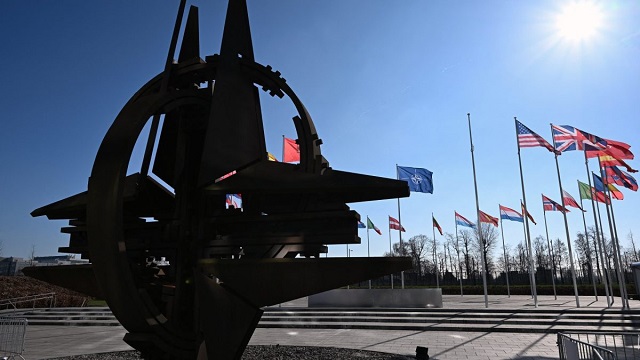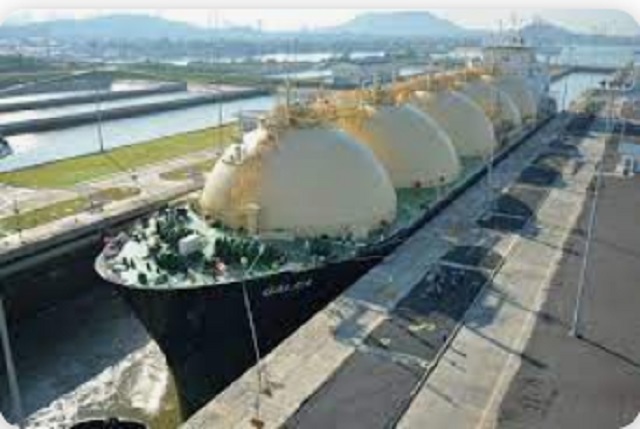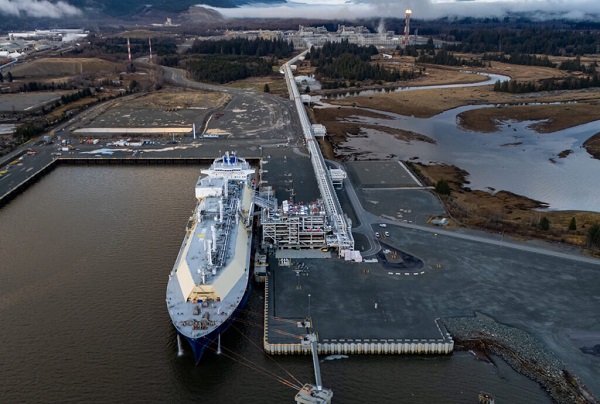Alberta
NATO reps say U.S., Canada oil and gas critical for energy security

Outside NATO headquarters ahead of a flag-raising ceremony for Sweden’s accession to NATO, in Brussels on February 27, 2024. Getty Images photo
From the Canadian Energy Centre
‘The traditional energy system will not disappear in a day’
Canada and the United States now produce more oil and gas than anywhere else on Earth, including the Middle East, according to a new report by S&P Global.
This blanket of energy security extends beyond borders and is “a powerful card to play” in increasingly unstable times, researchers wrote.
They found that without oil and gas produced in the U.S. and Canada – which has more than doubled since 2008 – North America, Europe and the rest of the world would have been “notably more vulnerable” following Russia’s invasion of Ukraine in 2022.
The ‘massive social impact’ of energy insecurity
Energy insecurity is all too familiar for Lithuanian Juljius Grubliauskas, who works for the North Atlantic Treaty Alliance (NATO).
Growing up, he was on hand when the Soviet Union weaponized energy in an attempt to topple Lithuania’s fledgling independence.
“I remember clearly from my childhood in 1990 when the Russians cut off energy supplies to try to break the resolve of the Lithuanians, [and] that affected the daily lives of every citizen,” Grubliauskas told a recent webinar hosted by the Toronto-based Institute for Peace and Diplomacy.
“Having a lack of energy has a massive social impact and massive cascading effects like prices immediately jumping, massive inflation and such,” he said.
“Today obviously many things have changed and the energy landscape looks much different, but the principle that energy is closely linked to national security and the independence of nations to make their decisions still remains true.”
North America’s role in NATO energy supply
Formed following the second world war, NATO represents 31 nations in Europe and North America in shared collective defense where an attack on one is seen as an attack on all.
NATO is finalizing a strategic plan for its energy future as the world seeks to reduce emissions, focusing primarily on secure access for military forces, Grubliauskas said.
Oil and gas from North America play a critical role, said Brussels-based NATO energy security policy expert Can Ögütcü.
“We need to be sure that we’re going to have security of supply of production in the U.S. and in Canada,” he said.
“We have last one import supplier, the Russians, [and] we are in the transition to perhaps also lose another big supplier, the Middle East Gulf countries, as maritime routes become more and more insecure.”
Critical North American energy integration
While Canadian oil and gas exports currently go almost exclusively to the U.S., once they enter the integrated pipeline system, they can become so-called “re-exports” from U.S. Gulf Coast to overseas markets.
At the end last year, the U.S. imported more oil from Canada than ever before, according to the U.S. Energy Information.
At the same time, America exported a record 11.5 million barrels per day of oil and petroleum products, and a record 709 billion cubic feet of natural gas.
“North American energy integration, things like the Enbridge Line 3 pipeline and the Keystone pipeline are absolutely crucial pieces of infrastructure, not just for the energy security of North America but also increasingly for the energy security of NATO allies,” said Joseph Calnan, energy security analyst with the Canadian Global Affairs Institute.
“The traditional energy system will not disappear in a day. Climate change of course makes it imperative that we do reduce our emissions globally but the role of Canada in the short term and medium term, I believe, is to firm up this traditional energy system.
“While Canada has a major role to play in future energy technologies, the current energy technologies are in my opinion, the priority.”
Canada can do more
Canada has not done enough to improve world energy security, said Heather Exner-Pirot, a senior fellow with the Macdonald-Laurier Institute.
“In the wake of Russia’s invasion, Canada has not stepped up and there is risk on all sides from depending too much on OPEC, or Qatar or Russia, but also too much on the United States,” she said, referencing the U.S. decision to pause approvals of new liquefied natural gas (LNG) export projects.
“We can do much more shipping on the East Coast. There are projects that were in the pipeline that have been rejected by the federal government and by provincial governments that could be going to Europe. Obviously on the West Coast is more promising.”
Major projects slated to start up soon like the Trans Mountain expansion and LNG Canada terminal will grow global access to Canadian oil and gas, primarily in the Indo Pacific region, Calnan noted.
“I think we’ll see that Canada has a much larger role to play in the total global market, which will have a stepwise influence on the situation in Europe,” he said.
Alberta
The case for expanding Canada’s energy exports

From the Canadian Energy Centre
For Canada, the path to a stronger economy — and stronger global influence — runs through energy.
That’s the view of David Detomasi, a professor at the Smith School of Business at Queen’s University.
Detomasi, author of Profits and Power: Navigating the Politics and Geopolitics of Oil, argues that there is a moral case for developing Canada’s energy, both for Canadians and the world.
CEC: What does being an energy superpower mean to you?
DD: It means Canada is strong enough to affect the system as a whole by its choices.
There is something really valuable about Canada’s — and Alberta’s — way of producing carbon energy that goes beyond just the monetary rewards.
CEC: You talk about the moral case for developing Canada’s energy. What do you mean?
DD: I think the default assumption in public rhetoric is that the environmental movement is the only voice speaking for the moral betterment of the world. That needs to be challenged.
That public rhetoric is that the act of cultivating a powerful, effective economic engine is somehow wrong or bad, and that efforts to create wealth are somehow morally tainted.
I think that’s dead wrong. Economic growth is morally good, and we should foster it.
Economic growth generates money, and you can’t do anything you want to do in social expenditures without that engine.
Economic growth is critical to doing all the other things we want to do as Canadians, like having a publicly funded health care system or providing transfer payments to less well-off provinces.
Over the last 10 years, many people in Canada came to equate moral leadership with getting off of oil and gas as quickly as possible. I think that is a mistake, and far too narrow.
Instead, I think moral leadership means you play that game, you play it well, and you do it in our interest, in the Canadian way.
We need a solid base of economic prosperity in this country first, and then we can help others.
CEC: Why is it important to expand Canada’s energy trade?
DD: Canada is, and has always been, a trading nation, because we’ve got a lot of geography and not that many people.
If we don’t trade what we have with the outside world, we aren’t going to be able to develop economically, because we don’t have the internal size and capacity.
Historically, most of that trade has been with the United States. Geography and history mean it will always be our primary trade partner.
But the United States clearly can be an unreliable partner. Free and open trade matters more to Canada than it does to the U.S. Indeed, a big chunk of the American people is skeptical of participating in a global trading system.
As the United States perhaps withdraws from the international trading and investment system, there’s room for Canada to reinforce it in places where we can use our resource advantages to build new, stronger relationships.
One of these is Europe, which still imports a lot of gas. We can also build positive relationships with the enormous emerging markets of China and India, both of whom want and will need enormous supplies of energy for many decades.
I would like to be able to offer partners the alternative option of buying Canadian energy so that they are less reliant on, say, Iranian or Russian energy.
Canada can also maybe eventually help the two billion people in the world currently without energy access.
CEC: What benefits could Canadians gain by becoming an energy superpower?
DD: The first and primary responsibility of our federal government is to look after Canada. At the end of the day, the goal is to improve Canada’s welfare and enhance its sovereignty.
More carbon energy development helps Canada. We have massive debt, an investment crisis and productivity problems that we’ve been talking about forever. Economic and job growth are weak.
Solving these will require profitable and productive industries. We don’t have so many economic strengths in this country that we can voluntarily ignore or constrain one of our biggest industries.
The economic benefits pay for things that make you stronger as a country.
They make you more resilient on the social welfare front and make increasing defence expenditures, which we sorely need, more affordable. It allows us to manage the debt that we’re running up, and supports deals for Canada’s Indigenous peoples.
CEC: Are there specific projects that you advocate for to make Canada an energy superpower?
DD: Canada’s energy needs egress, and getting it out to places other than the United States. That means more transport and port facilities to Canada’s coasts.
We also need domestic energy transport networks. People don’t know this, but a big chunk of Ontario’s oil supply runs through Michigan, posing a latent security risk to Ontario’s energy security.
We need to change the perception that pipelines are evil. There’s a spiderweb of them across the globe, and more are being built.
Building pipelines here, with Canadian technology and know-how, builds our competitiveness and enhances our sovereignty.
Economic growth enhances sovereignty and provides the resources to do other things. We should applaud and encourage it, and the carbon energy sector can lead the way.
Agriculture
Growing Alberta’s fresh food future

A new program funded by the Sustainable Canadian Agricultural Partnership will accelerate expansion in Alberta greenhouses and vertical farms.
Albertans want to keep their hard-earned money in the province and support producers by choosing locally grown, high-quality produce. The new three-year, $10-milllion Growing Greenhouses program aims to stimulate industry growth and provide fresh fruit and vegetables to Albertans throughout the year.
“Everything our ministry does is about ensuring Albertans have secure access to safe, high-quality food. We are continually working to build resilience and sustainability into our food production systems, increase opportunities for producers and processors, create jobs and feed Albertans. This new program will fund technologies that increase food production and improve energy efficiency.”
“Through this investment, we’re supporting Alberta’s growers and ensuring Canadians have access to fresh, locally-grown fruits and vegetables on grocery shelves year-round. This program strengthens local communities, drives innovation, and creates new opportunities for agricultural entrepreneurs, reinforcing Canada’s food system and economy.”
The Growing Greenhouses program supports the controlled environment agriculture sector with new construction or expansion improvements to existing greenhouses and vertical farms that produce food at a commercial scale. It also aligns with Alberta’s Buy Local initiative launched this year as consumers will be able to purchase more local produce all year-round.
The program was created in alignment with the needs identified by the greenhouse sector, with a goal to reduce seasonal import reliance entering fall, which increases fruit and vegetable prices.
“This program is a game-changer for Alberta’s greenhouse sector. By investing in expansion and innovation, we can grow more fresh produce year-round, reduce reliance on imports, and strengthen food security for Albertans. Our growers are ready to meet the demand with sustainable, locally grown vegetables and fruits, and this support ensures we can do so while creating new jobs and opportunities in communities across the province. We are very grateful to the Governments of Canada and Alberta for this investment in our sector and for working collaboratively with us.”
Sustainable Canadian Agricultural Partnership (Sustainable CAP)
Sustainable CAP is a five-year, $3.5-billion investment by federal, provincial and territorial governments to strengthen competitiveness, innovation and resiliency in Canada’s agriculture, agri-food and agri-based products sector. This includes $1 billion in federal programs and activities and $2.5 billion that is cost-shared 60 per cent federally and 40 per cent provincially/territorially for programs that are designed and delivered by provinces and territories.
Quick facts
- Alberta’s greenhouse sector ranks fourth in Canada:
- 195 greenhouses produce $145 million in produce and 60 per cent of them operate year-round.
- Greenhouse food production is growing by 6.2 per cent annually.
- Alberta imports $349 million in fresh produce annually.
- The program supports sector growth by investing in renewable and efficient energy systems, advanced lighting systems, energy-saving construction, and automation and robotics systems.
Related information
-

 Business2 days ago
Business2 days agoCanada Can Finally Profit From LNG If Ottawa Stops Dragging Its Feet
-

 Automotive15 hours ago
Automotive15 hours agoThe $50 Billion Question: EVs Never Delivered What Ottawa Promised
-

 National2 days ago
National2 days agoLiberal bill “targets Christians” by removing religious exemption in hate-speech law
-

 Crime2 days ago
Crime2 days agoInside the Fortified Sinaloa-Linked Compound Canada Still Can’t Seize After 12 Years of Legal War
-

 Energy2 days ago
Energy2 days agoLNG NOW! Canada must act fast to prosper in changing times
-

 Health1 day ago
Health1 day agoUS podcaster Glenn Beck extends a lifeline to a Saskatchewan woman waiting for MAiD
-

 Local Business12 hours ago
Local Business12 hours agoRed Deer Downtown Business Association to Wind Down Operations
-

 C2C Journal14 hours ago
C2C Journal14 hours agoWisdom of Our Elders: The Contempt for Memory in Canadian Indigenous Policy







